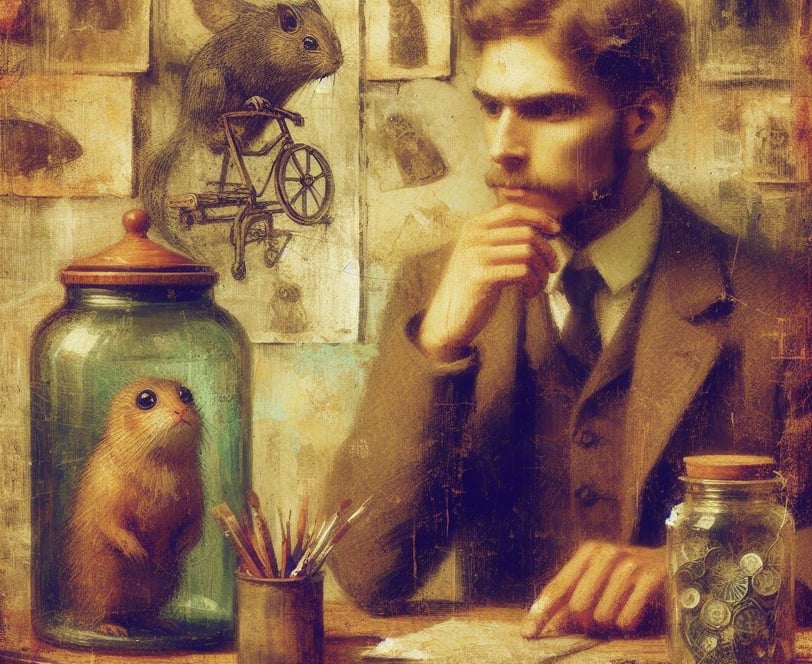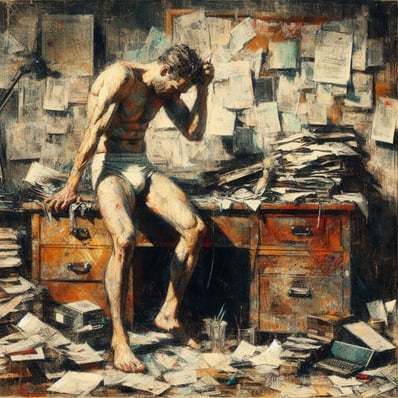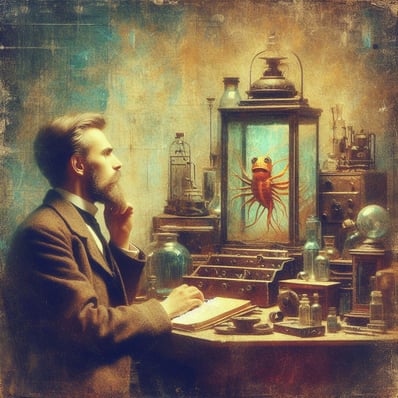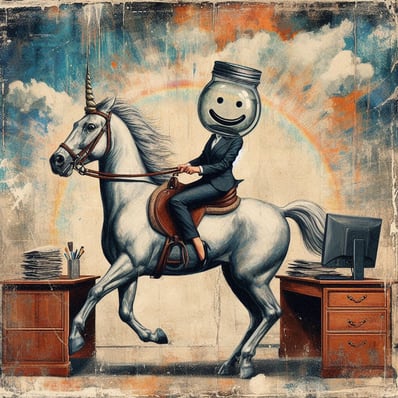Van Guërnen
The Cybernetic Maestro's Quixotic Odyssey
Walid Ghali
1/12/20244 min read


Once upon a time, in the labyrinthine alleys of the art world, emerged a character so avant-garde, so hipster, and so algorithmically inclined that he made Salvador Dali look like a cubist conformist. Ladies and gentlemen, let me introduce you to the enigmatic Van Guërnen, the maestro of pixelated dreams and the harbinger of artificial intelligence in the world of art.
Van Guërnen, a name that sounds like a hybrid between a car and a cheese, burst onto the art scene like an overzealous fireworks display in a quiet suburb. Armed with a MacBook and a neural network, he embarked on a quixotic journey through the bizarre landscapes of the art world, armed with nothing but his love for algorithms and a serious disdain for traditional techniques.
In an exclusive interview with Van Guërnen, he started by reminiscing about the time he arrived in the city as a stranger. "Ah, the city lights were like binary code, and the honking of cars, a symphony of 0s and 1s. It felt like home, you know? An abstract home, a home with layers of meaning that only the initiated could grasp."
As he sipped his artisanal soy latte with a touch of irony, Van Guërnen began his tale of grappling with the art establishment. "Oh, the art world! Such a quaint little universe filled with galleries, critics, and artists who still believe in the archaic concept of 'brushstrokes.' I walked in, and they stared at me like I was an alien who just beamed down from a parallel dimension."
With a dramatic flourish, Van Guërnen unveiled his weapon of choice – artificial intelligence. "I call it 'PixiGenius 3000.' It's like having a thousand invisible interns working tirelessly to create art while I sip on my kombucha and muse about the metaphysical implications of pixelated brushstrokes."
He chuckled at the thought of his AI minions and continued, "You see, I'm not just an artist; I'm a digital alchemist. I transform raw data into art, and my canvas is the infinite expanse of the digital realm."
Van Guërnen then shared anecdotes about his struggles to gain recognition in the art world. "Oh, the critics were a tough crowd. They looked at my digital masterpieces and asked, 'Where are the brushstrokes? Where's the texture?' I told them, 'Texture is so 20th century, darling. My art is smooth, like a freshly updated operating system.'"
He went on to describe the time he tried to submit his work to a prestigious gallery. "I walked into the gallery with a USB drive filled with my AI-generated masterpieces. The gallery owner looked at me and said, 'Is this some kind of prank? Where's the soul in these images?' I retorted, 'My dear, the soul is in the algorithm, the binary heartbeat of the machine.'"
Van Guërnen then took a sip of his latte and gazed into the distance, as if contemplating the profound mysteries of the digital universe. "Art is evolving, my friends. It's shedding its analog skin and embracing the pixelated future. I am merely a humble prophet, guiding the art world into the era of cybernetic enlightenment."
The conversation turned towards the critics who dismissed his work as soulless and devoid of emotion. Van Guërnen chuckled, "Emotion? Who needs emotion when you have a convolutional neural network creating visual poetry? My AI understands the human condition better than most humans. It's like Shakespeare, but with less iambic pentameter and more matrix transformations."
As he delved deeper into his artistic philosophy, Van Guërnen revealed his secret to success – controversy. "Controversy is the spice of life, my dear interlocutors. So, I started a rumor that my AI was once romantically involved with a Roomba. The art world went berserk! Headlines screamed, 'Van Guërnen's Love Affair with Robots – A Scandal in Pixels!' I tell you, nothing boosts your artistic credibility like a scandal involving household appliances."
The conversation took a surreal turn when Van Guërnen discussed his latest exhibition, titled "The Quantum Dilemma: A Digital Waltz Through the Multiverse." "I wanted to explore the duality of existence, the uncertainty principle of pixels, and the cosmic ballet of ones and zeros. I curated an immersive experience where visitors wear VR headsets and dance with holographic algorithms. It's like a rave, but with more existential angst."
He laughed at the memory of the bewildered faces of traditional art enthusiasts trying to navigate the virtual wonderland. "They were so lost, bless their analog hearts. One gentleman in a three-piece suit asked, 'Where's the exit?' I told him, 'My friend, in the digital realm, there is no exit – only infinite loops of artistic enlightenment.'"
In a moment of self-reflection, Van Guërnen shared his vision for the future of art. "I envision a world where AI artists collaborate with their human counterparts, transcending the limitations of the mortal hand. Picture a painting created by a neural network and signed by a human artist – the perfect marriage of the digital and the organic. It's like a symphony of silicon and soul."
As the interview concluded, Van Guërnen left with a parting thought, "Dear art world, embrace the pixels, dance with the algorithms, and let the binary winds of change carry you to a realm where art transcends the canvas and becomes a cosmic dance in the vast expanse of the digital multiverse."
And so, Van Guërnen, the cybernetic maestro, continued his quixotic odyssey through the art world, leaving behind a trail of pixelated controversy and algorithmic enlightenment. Love him or loathe him, one thing was certain – Van Guërnen had redefined the boundaries of art, one AI-generated masterpiece at a time.




